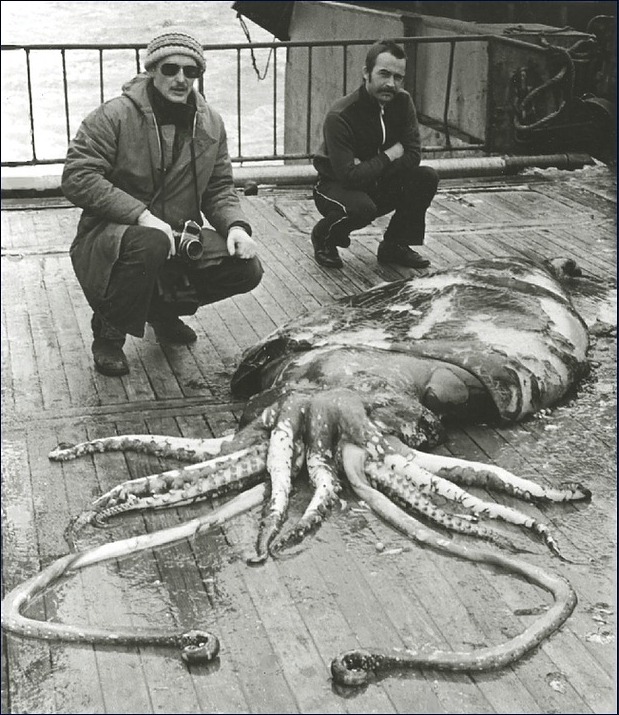Colossal Squid (Mesonychoteuthis hamiltoni) - Wiki Colossal Squid
From Wikipedia, the free encyclopedia
[Photo] Colossal Squid caught by Soviet trawler in 1981. This specimen, an immature female, was caught at 760 m (2500 feet) in the Antarctic off Dronning Maud Land by the Soviet trawler Evrica in 1981. Photograph by Alexander Remeslo. Copyright: Alexander Remeslo (photographer)
The Colossal Squid (Mesonychoteuthis hamiltoni), sometimes called the Antarctic or Giant Cranch Squid, is believed to be the largest squid species. It is the only member of the genus Mesonychoteuthis. Though it is known from only a few specimens, current estimates put its maximum size at 12???14 metres (39???46 feet) long, based on analysis of smaller and immature specimens, making it the largest known invertebrate.
Biology
Unlike the giant squid, whose tentacles are equipped with suckers lined with small teeth, the suckers at the tips of the Colossal Squid's tentacles have sharp swiveling hooks. Its body is wider and stouter, and therefore heavier, than that of the giant squid. Colossal Squids are believed to have a longer mantle than giant squids, although their tentacles are shorter.
The beak of Mesonychoteuthis hamiltoni is the largest known of any squid, exceeding that of Architeuthis in size and robustness. The Colossal Squid is also believed to have the largest eyes in the animal kingdom (even larger than those of giant squid).
The squid's known range extends thousands of miles northward from Antarctica to southern South America, southern South Africa, and the southern tip of New Zealand, making it primarily an inhabitant of the entire circumantarctic Southern Ocean.
While little is known about the life of this creature, it is believed to hunt prey such as chaetognatha, large fish like the Patagonian toothfish and other squid in the deep ocean using bioluminescence. Based on capture depths of a few specimens, as well as beaks found in sperm whale stomachs, the adult squid ranges at least to a depth of 2200 meters, while juveniles can go as deep as 1000 meters. A mature female is generally much larger than a mature male, as in many invertebrate species. (See Sexual dimorphism.)
The squid's method of reproduction has not been observed, although some data on their reproduction can be inferred from anatomy. Since males lack an organ called a hectocotylus (a tentacle used in other cephalopods to transfer a spermatophore to the female), they probably use a penis instead, which would be used to directly implant sperm into females.
Many Sperm whales carry scars on their backs believed to be caused by the hooks of Colossal Squid. Colossal Squid are a major prey item for Antarctic sperm whales feeding in the Southern Ocean; 14% of the squid beaks found in the stomachs of these sperm whales are those of the Colossal Squid, which indicates that Colossal Squid make up 77% of the biomass consumed by these whales. Many other animals also feed on this squid, including the beaked whales (such as the bottlenose whales), Pilot Whale, Southern Elephant Seal, Patagonian toothfish, Pacific sleeper shark, and albatross (e.g., the Wandering and Sooty albatrosses). However, beaks from mature adults have only been recovered from those animals large enough to take such prey (i.e., the sperm whale and Pacific sleeper shark), while the remaining predators are limited to eating juveniles or young adults.
...
http://en.wikipedia.org/wiki/Colossal_Squid
| The text in this page is based on the copyrighted Wikipedia article shown in above URL. It is used under the GNU Free Documentation License. You may redistribute it, verbatim or modified, providing that you comply with the terms of the GFDL. |
